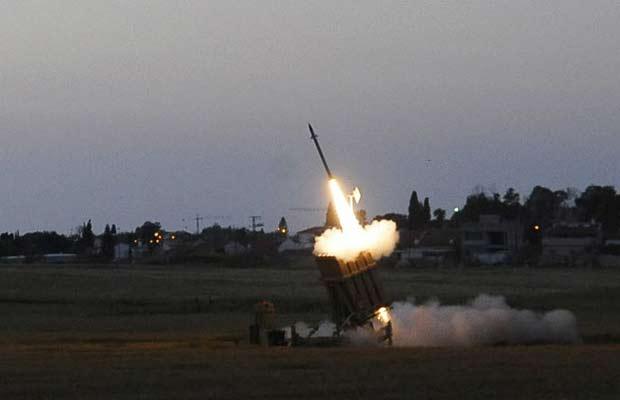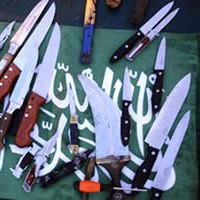![]()
Sun, April 10, 2011 | DebkaFile

A, Israeli missile is launched from the Iron Dome missile system in response to a rocket launch from the nearby Palestinian Gaza Strip close to the Israeli city of Ashkelon on April 9, 2011. (Photo by: AFP)
Israeli Leaders Succumbed to a “Ceasefire” Deal, but Hamas will Press On with its Terrorist Campaign
A DebkaFile Report:
Prime Minister Binyamin Netanyahu and Defense Minister Ehud Barak were expected at long last to instruct new chief of staff Lt. Gen. Benny Gantz to take effective military action to put a stop to the missile misery inflicted on hundreds of thousands of Israeli civilians month after month, year after year — or so the victimized communities believed.
After all, almost a million civilians in seven Israeli towns were at the receiving end of 120 missile and mortar shells between Friday and Saturday, April 8-9.
But Sunday, April 10, they learned that their government had succumbed to a “ceasefire” deal that would perpetuate the harassment: Hamas and the Jihad Islami agreed to desist from attacking Ashdod, Beersheba, Ofakim and Netivot, Palmachim and Kiryat Gat, the towns at the outer edge of their range, but permitted to keep up their regular mortar and missile fusillade against the communities abutting on the Gaza Strip.
The IDF agreed to suspend its counter-actions by land, air and sea. Although 17 Hamas commanders had been killed in those 48 hours, Israeli strikes had left intact the Islamists’ capabilities for expanding their attacks as far as Israel’s heartland around Tel Aviv any time they saw fit — as they have done so many times in the past.
The communities not covered by the deal would have to keep on dodging between bomb shelters instead of living normal lives.
Sunday, as the cabinet deliberated its next steps, the Palestinians fired five mortar rounds and 3 Qassam missiles at their usual targets, the small communities of Sderot, Shear Hanegev and the Eshkol farm district. By the end of the day, 20 projectiles had been fired from Gaza.
A missile was also aimed at the town of Ashkelon to test the limits acceptable to Israel. It was intercepted by the new Iron Dome anti-missile system and Israeli withheld military response. Hamas and Jihad Islami were allowed to infer that southern Ashkelon was fair game.
Sunday afternoon, Netanyahu staged a photo op with one of the two Iron Dome systems, saying the IDF was under orders to restore calm and security to southwestern Israel. His words fell on skeptical ears. By then, his audience in southwestern Israel knew their case was lost after hearing Ehud Barak’s cynical comment in a radio interview that morning that anyone looking for a quiet life “should go to Finland or Switzerland.”
This was the sort of remark Israelis are used to hearing from Palestinian extremists and Iranian leaders in their references to “the Zionists.”
Abandoned to their fate, the missile-battered communities did not miss the contrasting hoots of jubilation coming from the Gaza Strip close by. Palestinian radical leaders were celebrating their victory over Israel: Having won a license to keep up their attacks within certain limits, they were sure they could manipulate Israel into giving up its control of the 500-meter deep buffer sector of Gaza which the IDF had placed off-limits to armed terrorists. They will no doubt put that to the test as well as soon as the “ceasefire” gets underway.
For now, three facts stand out:
One: The IDF is standing by its “ceasefire” commitment.
Two: Hamas has stopped shooting the heavy Grad at the Israeli towns targeted a day ago. It is keeping up its steady trickle of mortar and missile fire on the Gaza border communities.
Three: Israeli policy-makers are glorifying the Iron Dome as a wonder weapon — which after years of further development it may turn out to be — to get them off the hook of offensive action against Hamas.
In the last three days, the system intercepted less than 10 out of the scores of incoming missiles. It is not designed to catch smaller projectiles, including mortar shells. Two anti-missile weapons have been experimentally deployed in Ashkelon and Beersheba; none at the border communities which take the daily brunt of Hamas attacks, partly because they are expensive, $50 million a piece.
Yet Defense Minister Barak told those communities who are faced with keeping their children behind doors throughout the Passover holiday: “Now you are protected.”
Netanyahu slightly more subtly celebrated the Iron Dome as a “defensive triumph and an offensive gain against Hamas attacks.
The chief of staff added his two bits to the show by remarking that the IDF would continue to act with “resolve, good judgment and the necessary assertiveness as necessary.” He was even heard to declare that “the situation in the South was calmer now than before.” (sic)
The strategic edge over Hamas aggression offered by the Iron Dome and its potential defensive value was thrown away by the government’s submission to Hamas “ceasefire” terms, which also gave the Palestinian group a chance to assess the impact of the new weapon and weigh counter-measures. Hoping to outwit the homemade Israeli anti-missile weapon, Hamas fired missiles in volleys, only to discover for the first time that Iron Drone was designed to catch multiple firings not just singles.
The Palestinian radicals understood this to mean that Netanyahu government had given up plans to disarm them and was content with improving defensive capabilities to protect civilians.
If view of this equation, Israel now faces the following prospects — if the partial ceasefire holds:
1. In the short term, missile and mortar attacks will continue at a reduced level. But armed terrorists will continue their attempts to breach the Gaza border for attacks inside Israel. The “ceasefire” terms do not restrict this kind of Palestinian terror.
2. Gaza’s Hamas rulers will try and gain on the points they have won to force Israel to part with more concessions. They can be expected to use their friends and allies in Europe, the United Nations and the Arab world to make Israel lift its land, sea and air blockade over Gaza and so permit weapons shipments and other strategic assets untrammeled access to the enclave. The Egyptian military junta will no doubt end its blockade and open Rafah to free movement between the Gaza Strip and Sinai.
3. Hamas will press on with its terrorist campaign, which started with the massacre of five Fogel family members in Itamar on the West Bank on March 11 and continued with the Jerusalem bus terminal bombing on the 23rd. The Islamists are known to be planning more murderous operations and abductions over the Passover festival which starts on April 18.
4. Tehran, Damascus and Beirut must have taken note of the way Israel buckled under the Hamas missile offensive — and so to will Cairo. They will all pat the Hamas military leader Ahmad Jabary on the back for persuading the organization’s political leaders in Damascus that, however much they escalated their attacks, the Netanyahu government would hold back from an effective ground operation for destroying its military infrastructure and weapons stocks.
Palestinian propagandists have managed to turn the relative roles of aggressor and victim upside down and are presenting Hamas as the injured party — or at the very least Israel as equally at fault for the violence.
The anti-Israel Arab League Secretary Amr Moussa quickly picked up this line. Sunday, he called on the UN Security Council to enforce a no-fly zone over the Gaza Strip, a ludicrous bid to equate Israel’s defensive operations against a terrorist organization which has declared war on the Jewish state with Muammar Qaddafi’s armed might against a domestic rebellion.



 RSS
RSS










Latest Comments
... [Trackback] [...] Read More: crethiplethi.com/contact-form/trackback/ [...]...
Hello Mike, Thank you for your positive feedback to the article. I felt there wasn’t too much critical analysis of ...
Thanks for this considered and well constructed article. A follow up article on the manner in which the editorial contro...
THE CLUELESSNESS OF CLAIMING THAT OBAMA'S MIDDLE EAST POLICIES WERE A FAILURE CANNOT BE FURTHER FROM THE TRUTH, WHAT THE...
As long as Obama is the president of the usa do not trust the us government......